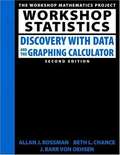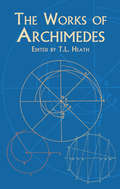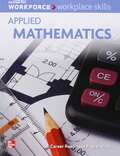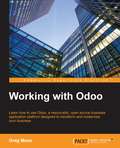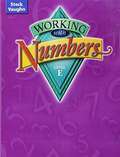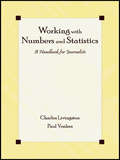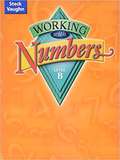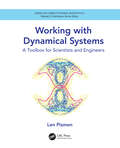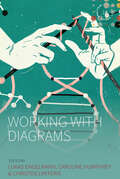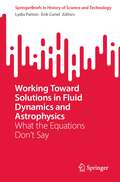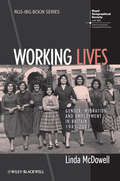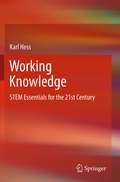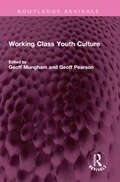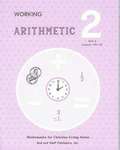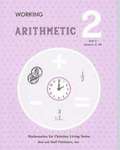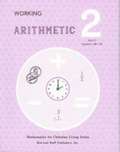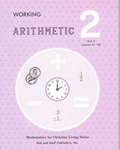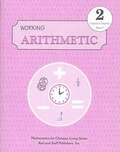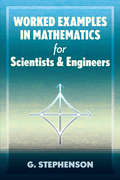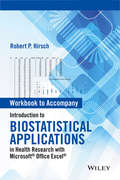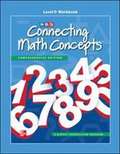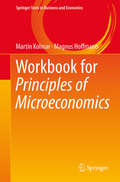- Table View
- List View
Workshop Statistics: Discovery with Data and the Graphing Calculator 2nd Edition
by Allan J. Rossman Beth L. Chance J. Barr von OehsenWorkshop Statistics emphasizes doing statistics as a way of learning statistics concepts and techniques. It assumes the use of the TI-83 graphing calculator. The "workshop approach" builds upon analysis of genuine data and provides practical experience. Unique in its format, an extensive series of over 90 practical activities and exercises leads students to discover statistical concepts, explore statistical principles, and apply statistical techniques. The book is widely praised as being one of the most innovative introductory texts for learning statistics.
The Works of Archimedes: Edited In Modern Notation With Introductory Chapters (Dover Books on Mathematics)
by Thomas Heath ArchimedesThe complete works of antiquity's great geometer appear here in a highly accessible English translation by a distinguished scholar. Remarkable for his range of thought and his mastery of treatment, Archimedes addressed such topics as the famous problems of the ratio of the areas of a cylinder and an inscribed sphere; the measurement of a circle; the properties of conoids, spheroids, and spirals; and the quadrature of the parabola. This edition offers an informative introduction with many valuable insights into the ancient mathematician's life and thought as well as the views of his contemporaries. Modern mathematicians, physicists, science historians, and logicians will find this volume a source of timeless fascination.
Workplace Skills: Applied Mathematics, Student Workbook (Workforce Ser.)
by ContemporaryProvides review and practice opportunities for using mathematical reasoning, critical thinking, and the problem-solving skills that are required in today's workplace.
Working with Odoo
by Greg MossLearn how to use Odoo, a resourceful, open source business application platform designed to transform and modernize your business About This Book * Configure, manage, and customize Odoo to fit the needs of your business * Learn about the new Odoo 8 website builder and e-commerce features that are seamlessly integrated with Odoo's business applications * Perform step-by-step configurations of the most important Odoo applications using real-world examples Who This Book Is For This book is perfect for people who have never used Odoo and for those who would like to learn about more advanced features such as creating your own custom modules. In order to get the most out of this book, you should be comfortable with downloading and installing software and understand basic business concepts such as sales, purchasing, inventory management, and basic accounting. What You Will Learn * Configure a functioning customer relationship management system * Set up a purchasing and receiving system for your company that allows you to track inventory, costs, and profit * Implement manufacturing operations and processes using real-world examples that you can put to use in your own company * Discover the capabilities of Odoo's financial accounting and reporting features * Integrate powerful human resource applications that simplify the collection and management of employee information * Utilize Odoo's full featured project management application to organize tasks and track time and costs associated with billable projects * Customize Odoo without writing a line a code In Detail Odoo continues to gain momentum throughout the world in regards to providing the best platform for open source ERP installations. Now with Odoo 8, you have access to a powerful website builder, integrated e-commerce features, and a fast-growing community to help transform and modernize your business. With this practical guide, you will cover the essential modules to get Odoo up and running for your company. After installing Odoo, you will use its sales management application to enter quotes, create sales orders, and invoice customers. You will then learn how to integrate the CRM application to manage your leads and convert them into lucrative opportunities and sales. Next, you will set up your own purchase management system, assigning products to suppliers and tracking orders with the new warehouse management and routing system. Finally, you will learn how to use analytics to track project expenses and keep your accounts simple and easy to maintain and build an Odoo module to extend its functionality and make it work for you. Working with Odoo covers all the core installation and usage functionalities of this popular tool, helping you to fully implement a working ERP system through practical, advanced, real-world examples. Style and approach This book is a practical guide that uses real-world examples to teach you how to implement Odoo into your business.
Working With Numbers (Level E)
by Shea Steck-Vaughn StaffA best-selling classic, Working with Numbers is a straightforward series offering solid coverage and extra practice for grade-level math-skills an ideal alternative curriculum for struggling students or those requiring remediation.
Working With Numbers and Statistics: A Handbook for Journalists
by Charles Livingston Paul S. VoakesWorking With Numbers and Statistics: A Handbook for Journalists will bolster math skills and improve math confidence for journalists at all skill levels. Authors Charles Livingston and Paul Voakes developed this resource book to improve journalistic writing and reporting, enabling journalists to:*make accurate, reliable computations, which in turn enables one to make relevant comparisons, put facts into perspective, and lend important context to stories;*recognize inaccurate presentations, whether willfully spun or just carelessly relayed;*ask appropriate questions about numerical matters;*translate complicated numbers for viewers and readers in ways they can readily understand;*understand computer-assisted reporting; and*write livelier, more precise pieces through the use of numbers.The math is presented in a journalistic context throughout, enabling readers to see how the procedures will come into play in their work.Working With Numbers and Statistics is designed as a reference work for journalism students developing their writing and reporting skills. It will also serve professionals as a useful tool to improve their understanding and use of numbers in news stories.
Working with Numbers: Student Edition, Level B (Steck-Vaughn Working with Numbers Ser.)
by Weatherly Steck-Vaughn StaffA best-selling classic, Working with Numbers is a straightforward series offering solid coverage and extra practice for grade-level math skills. Useful as an alternative curriculum for struggling students or those requiring remediation. Student edition for Level B. Publisher: Harcourt School Format: 142 pages, paperback Grade: 2 ISBN: 9780739891575
Working with Dynamical Systems: A Toolbox for Scientists and Engineers (Series in Computational Biophysics)
by Len PismenThis book provides working tools for the study and design of nonlinear dynamical systems applicable in physics and engineering. It offers a broad-based introduction to this challenging area of study, taking an applications-oriented approach that emphasizes qualitative analysis and approximations rather than formal mathematics or simulation. The author, an internationally recognized authority in the field, makes extensive use of examples and includes executable Mathematica notebooks that may be used to generate new examples as hands-on exercises. The coverage includes discussion of mechanical models, chemical and ecological interactions, nonlinear oscillations and chaos, forcing and synchronization, spatial patterns and waves. Key Features: · Written for a broad audience, avoiding dependence on mathematical formulations in favor of qualitative, constructive treatment. · Extensive use of physical and engineering applications. · Incorporates Mathematica notebooks for simulations and hands-on self-study. · Provides a gentle but rigorous introduction to real-world nonlinear problems. · Features a final chapter dedicated to applications of dynamical systems to spatial patterns. The book is aimed at student and researchers in applied mathematics and mathematical modelling of physical and engineering problems. It teaches to see common features in systems of different origins, and to apply common methods of study without losing sight of complications and uncertainties related to their physical origin.
Working With Diagrams (Studies in Social Analysis #14)
by Lukas Engelmann, Caroline Humphrey Christos LynterisArising from the need to go beyond the semiotic, cognitive, epistemic and symbolic reading of diagrams, this book looks at what diagrams are capable of in scholarly work related to the social sciences. Rather than attempting to define what diagrams are, and what their dietic capacity might be, contributions to this volume draw together the work diagrams do in the development of theories. Across a range of disciplines, the chapters introduce the ephemeral dimensions of scientist’s interactions and collaboration with diagrams, consider how diagrams configure cooperation across disciplines, and explore how diagrams have been made to work in ways that point beyond simplification, clarification and formalization.
Working Toward Solutions in Fluid Dynamics and Astrophysics: What the Equations Don’t Say (SpringerBriefs in History of Science and Technology)
by Lydia Patton Erik CurielThis book focuses on continuing the long-standing productive dialogue between physical science and the philosophy of science. Researchers and readers who want to keep up to date on front-line scientific research in fluid mechanics and gravitational wave astrophysics will find timely and well-informed analyses of this scientific research and its philosophical significance. These exciting frontiers of research pose deep scientific problems, and raise key questions in the philosophy of science related to scientific explanation and understanding, theory change and assessment, measurement, interpretation, realism, and modeling. The audience of the book includes philosophers of science, philosophers of mathematics, scientists with philosophical interests, and students in philosophy, history, mathematics, and science. Anyone who is interested in the methods and philosophical questions behind the recent exciting work in physics discussed here will profit from reading this book.
Working Lives: Gender, Migration and Employment in Britain, 1945-2007 (RGS-IBG Book Series)
by Linda McDowellFull of unique and compelling insights into the working lives of migrant women in the UK, this book draws on more than two decades of in-depth research to explore the changing nature of women’s employment in post-war Britain. A first-rate example of theoretically located empirical analysis of labour market change in contemporary Britain Includes compelling case studies that combine historical documentation of social change with fascinating first-hand accounts of women’s working lives over decades Integrates information gleaned from more than two decades of in-depth research Revealing comparative analysis of the similarities and differences in the lives of immigrant working women in post-war Britain Features real-life accounts of women’s under-reported experiences of migration
Working Knowledge
by Karl HessWorking Knowledge: STEM Essentials for the 21st Century is designed to inspire a wide range of readers from high school and undergraduate students with an interest in Science, Technology, Engineering, and Mathematics (STEM) to STEM teachers and those who wish to become teachers. Written by renowned scientist and teacher Dr. Karl Hess of the University of Illinois at Urbana, a member of both the National Academy of Sciences and the National Academy of Engineering, the book presents a critical collection of timeless STEM concepts and connects them with contemporary research advances in addition to the needs of our daily lives. With an engaging and accessible style not requiring a formal background in STEM, Dr. Hess takes the reader on a journey from Euclidean Geometry and Cartesian Coordinates up through 21st Century scientific topics like the global positioning system, nanotechnology, and super-efficient alternative energy systems. Working Knowledge: STEM Essentials for the 21st Century at once serves as an almanac on the fascinating physical, chemical, quantitative features of the natural world and built environment, as well as a need-to-know list of topics for students, teachers, and parents interested in STEM education.
Working Class Youth Culture (Routledge Revivals)
by Geoff Mungham Geoff PearsonFirst published in 1976, Working Class Youth Culture offers a much-needed alternative viewpoint to the law-and-order lobby which treats the youth question as a dreadful pest to be exterminated or caged in. The contributors describe the real conditions of life for working-class youth; how they make sense of the world; and how we can understand their perspective. The subjects discussed include Teddy Boys, Mods, Skinheads and the Glamrock Cult; dance-hall fights; picking up girls and going steady; how schools manufacture delinquency, truancy and vandalism; how working-class kids slide from bad schools to bad jobs, or to no jobs at all; Paki-bashing, racism and the competition over jobs and houses; how social change in post-war Britain has influenced youth culture; and how social scientists have hidden the real character of youth troubles behind the myth of a classless society. This book will be of interest to students of sociology and anthropology.
Working Arithmetic Grade 2: Unit 1 Lessons 1-40
by Lois Myer Amy Herr Miriam Rudolph Marla MartinThe 170 lessons in Grade 2 are bound in five workbooks with tear-out pages. Unit 1 reviews addition and subtraction facts through 10 and other skills taught in Grade 1. Continuous review is built into the lessons and simple reading problems are practiced frequently. Speed drills are included. Money, time and measures are reviewed; half dollar, quarter hour, and pounds and ounces are introduced.
Working Arithmetic Grade 2: Unit 2 Lessons 41-60
by Lois Myer Amy Herr Miriam Rudolph Marla MartinThe 170 lessons in Grade 2 are bound in five workbooks with tear-out pages. Unit 2 teaches all the addition and subtraction facts for 11. Continuous review is built into the lessons and simple reading problems are practiced frequently. Speed drills are included in the workbooks. Money, time and measures are reviewed; half dollar, quarter hour, and pounds and ounces are introduced.
Working Arithmetic Grade 2: Unit 5 Lessons 138-170
by Lois Myer Amy Herr Miriam Rudolph Marla MartinThe 170 lessons in Grade 2 are bound in five workbooks with tear-out pages. Unit 5 teaches all the addition and subtraction facts for the 16's-18's. Continuous review is built into the lessons and simple reading problems are practiced frequently. Speed drills are included in the workbooks. Money, time and measures are reviewed; half dollar, quarter hour, and pounds and ounces are introduced.
Working Arithmetic Grade 2: Unit 3 Lessons 61-102
by Lois Myer Amy Herr Miriam Rudolph Marla MartinThe 170 lessons in Grade 2 are bound in five workbooks with tear-out pages. Unit 3 teaches all the addition and subtraction facts for the 12's and 13's and carrying and borrowing. Continuous review is built into the lessons and simple reading problems are practiced frequently. Speed drills are included. Money, time and measures are reviewed; half dollar, quarter hour, and pounds and ounces are introduced.
Working Arithmetic: Practice Sheets (Mathematics for Christian Living #Grade 2 Book 1)
by Rod and Staff Publishers Inc.Grade 2 Math Practice Sheets Book 1
Worked Examples in Nonlinear Continuum Mechanics for Finite Element Analysis
by Javier Bonet Antonio J. Gil Richard D. WoodMany processes in materials science and engineering, such as the load deformation behaviour of certain structures, exhibit nonlinear characteristics. The computer simulation of such processes therefore requires a deep understanding of both the theoretical aspects of nonlinearity and the associated computational techniques. This book provides a complete set of exercises and solutions in the field of theoretical and computational nonlinear continuum mechanics and is the perfect companion to Nonlinear Continuum Mechanics for Finite Element Analysis, where the authors set out the theoretical foundations of the subject. It employs notation consistent with the theory book and serves as a great resource to students, researchers and those in industry interested in gaining confidence by practising through examples. Instructors of the subject will also find the book indispensable in aiding student learning.
Worked Examples in Mathematics for Scientists and Engineers (Dover Books on Mathematics)
by G. StephensonThis rich collection of fully worked problems in many areas of mathematics covers all the important subjects students are likely to encounter in their courses, from introductory to final-year undergraduate classes. Because lecture courses tend to focus on theory rather than examples, these exercises offer a valuable complement to classroom teachings, promoting the understanding of mathematical techniques and helping students prepare for exams. They will prove useful to undergraduates in mathematics; students in engineering, physics, and chemistry; and postgraduate scientists looking for a way to refresh their skills in specific topics.The problems can supplement lecture notes and any conventional text. Starting with functions, inequalities, limits, differentiation, and integration, topics encompass integral inequalities, power series and convergence, complex variables, hyperbolic function, vector and matrix algebra, Laplace transforms, Fourier series, vector calculus, and many other subjects.
Workbook to Accompany Introduction to Biostatistical Applications in Health Research with Microsoft Office Excel
by Robert P. HirschWorkbook to accompany Introduction to Biostatistical Applications in Health Research with Microsoft Office Excel--practical and methodological approach to the statistical logic of biostatistics in the field of health research.
Workbook, Level D (SRA Connecting Math Concepts)
by Siegfried Engelmann Jerry Silbert Owen EngelmannNIMAC-sourced textbook
Workbook for Principles of Microeconomics (Springer Texts in Business and Economics)
by Martin Kolmar Magnus HoffmannThis is the companion workbook for the textbook Principles of Microeconomics. Each chapter features a wide variety of exercises, ranging from basic multiple-choice questions to challenging mathematical problems and case study scenarios. The textbook pursues an integrative approach to modern microeconomics by critically reflecting on the main findings of economics from a philosophical standpoint and comparing them to approaches found in the social sciences. It adopts an institutional perspective to analyze the potential and limitations of different market types, and highlights implications for the design of the legal system and business practices throughout. In addition to traditional rational-choice models, important findings from behavioral economics and psychology are also presented.
Workbook: Progress in Mathematics
by Elinor R. Ford Catherine D. Letourneau*This textbook has been transcribed in UEB, formatted according to Braille textbook formats, proofread and corrected. <P><P>Math Workbook Grade 3
